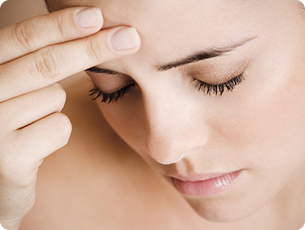
At Windmill Health Center, we know that headaches can hinder your normal lifestyle or at worst debilitate you. If you have a headache, you’re not alone. Nine out of ten Americans suffer from headaches. Some are occasional, some frequent, some are dull and throbbing, and some cause debilitating pain and nausea. The number of people who suffer from headaches every year is staggering, yet two-thirds of headache sufferers remain undiagnosed and in pain.
Don’t suffer in silence. Let the Weston chiropractors at Windmill Health Center bring you relief from headache pain!
Chronic daily headaches are classified by how long they last — more than four hours or less than four hours. The longer lasting headaches are more common and addressed here. Primarily, there are four types of headaches:
The two most common types of headaches we see at Windmill Heath Center are tension and migraine headaches.
Tension headaches occur five times more frequently in men than in women. Tension headaches usually start between 20 to 40 years old when stress levels from work and home increase. Chronic tension-type headaches have at least two of the following characteristics:
In addition, they cause no more than one of the following:
Migraine headaches generally occur 15 days or more a month, for at least three months. In addition, on eight or more days a month for at least three months, you might experience the following symptoms.
Your headaches have at least two of the following characteristics:
And they cause at least one of the following:
Do you find yourself frequently taking over-the-counter medications such as Excedrin, Advil, Nuprin, Aleve or Tylenol?
“These types of drugs only serve to dull and hide the pain,” Dr. Browner says, “they don’t treat the cause, or source of pain, which is why the headache returns.” With these common over-the-counter medications treating only the “symptoms”, headache-sufferers feel compelled to take more and more pain-relievers, subjecting them to the many harmful side effects these medications can cause.
Research shows that spinal manipulation – one of the primary forms of care provided by doctors of chiropractic – may be an effective treatment option for tension headaches and headaches that originate in the neck.
A report released in 2001 by researchers at the Duke University Evidence-Based Practice Center in Durham, NC, found that spinal manipulation resulted in almost immediate improvement for those headaches that originate in the neck, and had significantly fewer side effects and longer-lasting relief of tension-type headache than a commonly prescribed medication.
Also, a 1995 study in the Journal of Manipulative and Physiological Therapeutics found that spinal manipulative therapy is an effective treatment for tension headaches and that those who ceased chiropractic treatment after four weeks experienced a sustained therapeutic benefit in contrast with those patients who received a commonly prescribed medication.
© 2023 Windmill Health Center. All Rights Reserved.